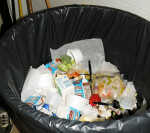No food fight here: students adjust to new school lunches

McCOOK, Nebraska -- Fruit or vegetables are not an option anymore at school lunches - they are mandatory.
New federal nutrition guidelines for school lunches from the US Department of Agriculture took effect this year and monitors the calorie intake of students. It also limits salt and sugar, phases in more whole grains and requires a half cup serving of fruit and vegetables. The USDA administers the school lunch program and schools who participate must comply with the new rules as part of the Healthy, Hunger-Free Kids Act of 2010.
There hasn't been much of an uproar from McCook students, according to officials, although participation in school lunches was down by 10 percent the first week of September, compared to last year, said Larry Young, general manager of Sodexo Foods, the company that provides lunches to the McCook and North Platte school districts.

Young has been in the food service industry for more than 20 years and said with all the changes through the years, this has been the hardest implementation yet.
The new rules mean he has to juggle menus for to make sure calories and required ounces of meat, meat alternative (like cottage cheese), dairy and whole grains are met on a weekly basis. It also means more frozen and fresh fruit and vegetables, as they have less sodium than canned.
For now, Young is trying out a combination of meal entrees to incorporate the new regulations yet make the meals nutritious and appetizing.

"We're trying to experiment with different spices to bring out the flavor in the foods," he said.
Each meal comes with five options, he said, with the student allowed to choose three. Of those three, one must be a half cup of fruit and vegetables.
And if they don't choose, there is an apple or carton of fruit juice at the check-out register that students must put on their plate, he said.
But, kids don't always like being told what to have on their tray, especially among high school students.
"If I force you to put an apple on your tray, and it's just thrown away, everyone is losing," Young said.
Linda Babcock, manager at the McCook Junior High cafeteria, said she hasn't heard a lot of grumbling from students.
"The kids balked at first, but now they're used to it," Babcock said, who added that she hasn't noticed a lot of fruit thrown away.
At one recent lunch at the McCook Junior High, students cheerfully grabbed an orange or apple as part of their lunch. But afterward, a long line of kids formed at the "Snack Bar," which sells cookies, pretzels, potato chips and Powerade.
"There's a line until the bell rings, it's non-stop," said Sodexo employee Diana Gull, who cited cookies as a top-seller.
The new requirements are part of the fight against childhood obesity and helping kids learn to make healthy food choices. They come with a six-cent federal reimbursement per meal to help off-set increase food costs.
Dawn Garcia, McCook Schools nurse and head of the school district's Wellness Committee, has not heard anything negative from students or parents about the new school lunches.
Changes were already being implemented in the lunches, she said, to improve nutritional content, with breads containing a portion of whole grain. Things aren't perfect now, she said, but at least there are more nutritious options for students. For some families, fruit and vegetables are not available, whether by choice or by cost.
"For some kids, lunch may be the only healthy meal they get all day," Garcia said. Obesity can affect a child in many ways, she said, not just health-wise but in self-esteem, too.
In other schools, the biggest battle seem to be portion size, due to calorie requirements. Students in Milwaukee boycotted the school lunch because of the smaller-sized meals. Calories are allocated according to age, with kindergarten to fifth-grade, 550 to 650 calories and for 9th- to 12th-grade, between 750 to 850 calories.
More changes are coming next year, Young said. Right now, lunches include bread that is partially whole wheat. Next year, it will be 100 percent whole grains. which will be a big change for some kids, he said
"A lot of these kids don't know what whole wheat bread is. It's darker, with more texture," he said. As far as other changes to the breakfast menu, he wasn't sure yet what that would entail.
But for now, most McCook students seem to be adjusting. When asked if he minded being told to add fruit to his lunch, one junior high student just shrugged.
"It's okay, I like fruit anyways," he said.
text box if needed
The guidelines approved by the USDA earlier this year set limits on calories and salt and phase in whole grains. Schools must offer at least one vegetable or fruit per meal. They can still serve chocolate milk, but it has to be nonfat. Guidelines include:
--Ensuring that students are offered both fruits and vegetables every day of the week;
--Substantially increasing offerings of whole grain-rich foods;
--Offering only fat-free or low-fat milk varieties;
--Limiting calories based on the age of children being served to ensure proper portion size; and
--Increasing the focus on reducing the amounts of saturated fat, trans fats and sodium.
USDA built the new rules around recommendations from a panel of experts convened by the Institute of Medicine. The standards were also updated with key changes from the 2010 Dietary Guidelines for Americans -- the Federal government's benchmark for nutrition -- and aimed to foster the kind of healthy changes at school that many parents are already trying to encourage at home, such as making sure that kids are offered both fruits and vegetables each day, more whole grains, and portion sizes and calorie counts designed to maintain a healthy weight.
